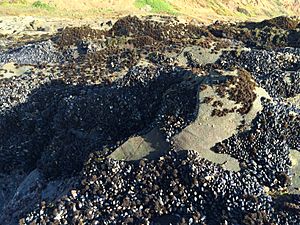California mussel facts for kids
Quick facts for kids California mussel |
|
|---|---|
 |
|
| Scientific classification | |
| Genus: |
Mytilus
|
| Species: |
californianus
|

The California mussel (Mytilus californianus) is a large mussel that you can eat. It's a type of ocean animal called a bivalve mollusk. These animals have two shells that are hinged together.
You can find California mussels along the west coast of North America. They live from northern Mexico all the way up to the Aleutian Islands in Alaska. These mussels often live in huge groups on rocks. They like the upper part of the intertidal zone, which is the area between high and low tide. Here, they are hit by strong ocean waves.
Contents
What Does a California Mussel Look Like?
The shell of a California mussel is very thick. It can be about 13 centimeters (5 inches) long, but some are even bigger! The outside of the shell is blue. It also has a thick brown outer layer called a periostracum, which often wears off.
The shell has rough lines that go out from the center. It also has uneven lines that show how it grew over time. The inside of the shell is blue and a little bit shiny.
Like other mussels, this animal sticks to rocks using a very strong, stretchy thread. This thread is called a byssus.
The mussel's shell is mostly made of minerals called carbonates. Scientists found that the type of carbonate in their shells changed over time. This change might be because of ocean acidification. Calcite, one type of carbonate, can handle acid better.
Where Do California Mussels Live?
California mussels like ocean water that is very salty. They also prefer places with little sediment, like sandy or muddy bits. They do best on open, rocky coasts.
It's hard for them to start growing on bare rocks. Instead, they prefer to settle near other mussels. They use their strong, thread-like byssus to attach themselves to hard surfaces.
If conditions are right, California mussels can grow up to 20 centimeters (8 inches) long. They can also live for more than 20 years! However, many mussels in the intertidal zone don't live that long. They can be damaged by floating wood or other things. Strong waves can also hurt them. They can also dry out, get sick, or be eaten by predators.
One of their main predators is the Pisaster starfish. California mussels eat tiny living things in the water called plankton.
How Do People Use California Mussels?
California mussels were a very important food for Native Americans living on the Pacific Coast long ago. On California's Northern Channel Islands, people have been eating them for almost 12,000 years!
Scientists found that the mussels harvested on San Miguel Island got smaller over 10,000 years. This might be because more people were fishing, which put pressure on the mussel populations. The Chumash also ate these mussels between 800 and 1300 AD.
Today, people still gather California mussels for food and for bait to catch fish. The meat inside the mussel is often orange. You can cook them by baking, boiling, or frying them, just like other mussels, clams, and oysters.
It's important to be careful when eating these mussels. Sometimes, during a "red tide", mussels can have harmful toxins. These toxins can make people sick with something called paralytic shellfish poisoning. So, it's best to only eat them when it's safe.
California Mussels in Science
The idea of a "keystone species" was first used in 1969. A zoologist named Robert T. Paine came up with this idea. He used it to explain the important relationship between the Pisaster ochraceus starfish and the Mytilus californianus mussel. A keystone species is one that has a very big impact on its ecosystem. If you remove it, the whole ecosystem changes a lot.

